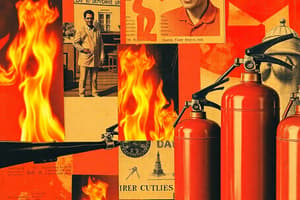Podcast
Questions and Answers
What are the components of the Fire Tetrahedron?
What are the components of the Fire Tetrahedron?
Heat, fuel, oxygen, chemical chain reaction
Which of the following materials are involved in a Class A Fire? (Select all that apply)
Which of the following materials are involved in a Class A Fire? (Select all that apply)
- Flammable liquids
- Textiles (correct)
- Electrical equipment
- Wood products (correct)
How are Class A Fires extinguished?
How are Class A Fires extinguished?
With water or AFFF
What type of materials does a Class B Fire involve?
What type of materials does a Class B Fire involve?
How are Class B Fires extinguished?
How are Class B Fires extinguished?
What should be done with a Class C Fire?
What should be done with a Class C Fire?
What dangers are associated with Class D Fires?
What dangers are associated with Class D Fires?
Which combustible metals are involved in Class D Fires? (Select all that apply)
Which combustible metals are involved in Class D Fires? (Select all that apply)
Flashcards are hidden until you start studying
Study Notes
Fire Tetrahedron
- Composed of four essential elements: heat, fuel, oxygen, and chemical chain reaction.
- All elements must be present for a fire to ignite and sustain.
Class A Fire
- Involves ordinary combustibles: wood, cloth, textiles, and paper products.
- Extinction methods include water delivered in a straight stream or fog pattern.
- Deep-seated fires may require aqueous film forming foam (AFFF) for effective suppression.
Class B Fire
- Pertains to flammable liquids like gasoline, diesel, jet fuels, and various oils.
- Extinguished with AFFF or potassium bicarbonate (PKP).
- Must be cautious with flammable gases; never extinguish without securing the gas flow first.
Class C Fire
- Involves energized electrical fires; must be treated with care.
- Use Carbon Dioxide or water spray, maintaining a safe distance.
- Best practice is to de-energize the electrical source and manage as a Class A fire if safe to do so.
Class D Fire
- Concerns combustible metals, including magnesium and titanium.
- Risk of small explosions when water is applied; water should not be used for suppression.
- Best approach is disposal overboard or special dry powder extinguishing agents.
Studying That Suits You
Use AI to generate personalized quizzes and flashcards to suit your learning preferences.




